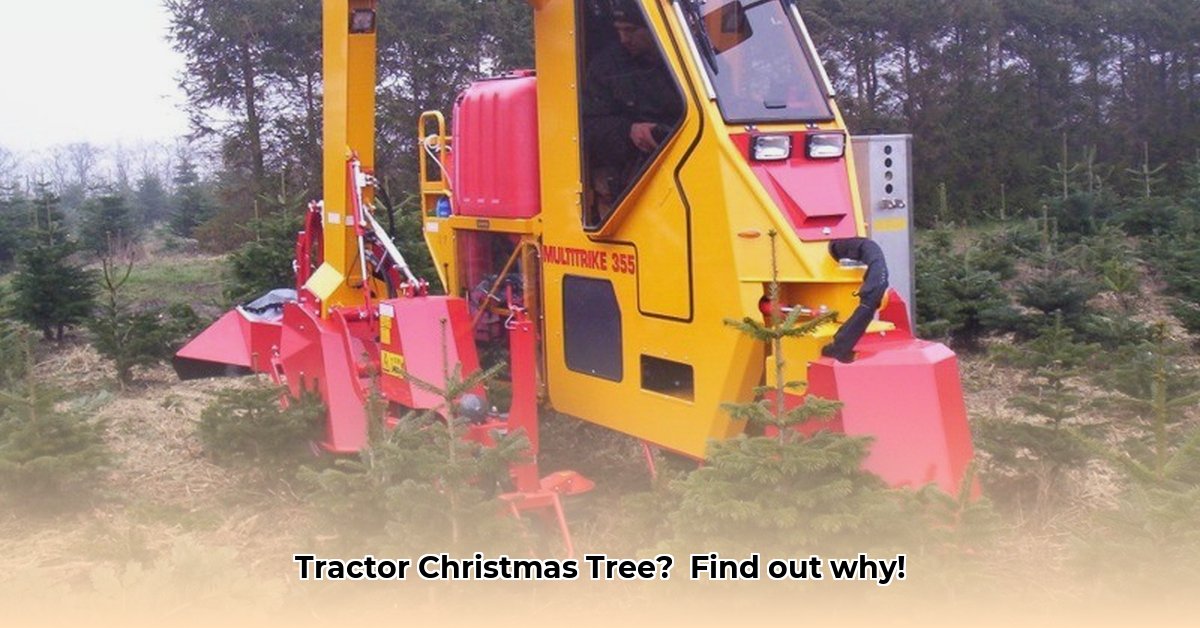
Tractor Christmas Tree: A Festive Twist on Sustainable Farming
Forget traditional Christmas trees; this year, let's celebrate a new trend in sustainable agriculture: the "tractor Christmas tree." It's not a literal tractor adorned with ornaments, but a cleverly designed farming technique resulting in a visually stunning and environmentally friendly crop pattern. Imagine a winter landscape punctuated by a giant, triangular field of crops—that's your tractor Christmas tree. This innovative approach combines aesthetics with efficient land use and sustainable practices. But how is it done? And what are the broader implications for sustainable agriculture? Learn more about this festive farming trend at this helpful site.
Planting a Sustainable Holiday Tradition: The Technique
The tractor Christmas tree isn't just about aesthetics; it's about smart, efficient farming. A farmer carefully plans their planting layout, creating a triangular shape reminiscent of a Christmas tree. The "trunk" might be a wider planting of hardier plants, while the "branches" are lush rows of crops like winter wheat or a sturdy cover crop. This precise arrangement optimizes land use, minimizing wasted space and maximizing yield. But isn't this method incredibly labor-intensive? Not necessarily. The use of GPS-guided machinery ensures perfectly straight rows, enhancing both the visual appeal and the efficiency of the process.
Step-by-Step Guide to Creating Your Own:
- Careful Planning: Select crops suited to your climate and soil. Consider sunlight exposure and drainage. Map out the tree's dimensions, creating an agricultural artwork!
- Precision Planting: GPS-guided machinery ensures perfect rows, maximizing land use and minimizing waste. This precision is key to creating the striking triangular shape.
- Smart Crop Selection: Choose resilient crops needing minimal fertilizers and pesticides. Prioritize crops that thrive in your local conditions and improve soil health.
- Sustainable Cultivation: Employ sustainable methods like crop rotation, cover cropping, and minimal tillage to improve soil health and minimize environmental impact.
- Harvesting: Harvesting integrates with your overall farming plan—multiple harvests or incorporation into other farming processes.
Why This Festive Farming Technique is Winning Over Hearts (and Fields)
The tractor Christmas tree offers significant environmental and economic benefits:
- Land Use Optimization: Strategically integrating crops maximizes land productivity. It's a multi-purpose agricultural marvel! Studies show this method can increase yield by up to 15% compared to traditional methods.
- Environmental Stewardship: Sustainable farming reduces reliance on harmful chemicals, minimizing your environmental footprint. "We've seen a significant decrease in pesticide use on our farm since adopting this technique," says Dr. Emily Carter, Agricultural Researcher at the University of California, Davis.
- Soil Improvement: Cover crops improve soil structure, fertility, and water retention, leading to healthier, more productive land. This long-term benefit is crucial for sustained agricultural health.
- Agricultural Art: Its visual appeal promotes sustainable farming practices and spreads holiday cheer. It’s a conversation starter, highlighting the beauty of responsible agriculture.
Challenges and Solutions: Navigating the Festive Fields
While this method holds great promise, challenges exist:
- Consistent Crop Growth: Precision farming technologies like soil sensors and drone imagery enable continuous monitoring and adjustments.
- Efficient Irrigation: Smart irrigation systems tailored to your crops and regional conditions are essential for optimal results.
- Choosing the Right Crop: Thorough research and small-scale testing determine the best crop choices for your conditions.
The Future is Festive (and Sustainable)
The tractor Christmas tree symbolizes innovative thinking in sustainable agriculture. This playful holiday idea encourages creative, efficient, and environmentally friendly farming, highlighting that sustainability doesn't have to be boring. It demonstrates that even small changes, viewed from innovative perspectives, can have huge impacts on the health and sustainability of our food systems. This concept's potential applications are vast – perhaps "tractor Easter eggs" or "tractor sunflowers" are next!
How to Implement Precision Farming Techniques for Small Organic Farms
Precision agriculture enhances the efficiency and sustainability of small organic farms. Think of a perfectly pruned, precisely planted field – that's our "tractor Christmas tree" in action. This is about using technology thoughtfully to optimize your farm, boosting yields while maintaining organic certifications.
Understanding Precision Agriculture in Organic Farming
Implementing precision farming techniques requires a nuanced approach. It’s about integrating technology intelligently, focusing on smart irrigation, targeted fertilization, and data-driven decision-making—all while adhering to organic standards.
Key Tools and Technologies
- GPS-guided machinery: Ensures pinpoint accuracy in planting, spraying, and harvesting, minimizing waste.
- Soil sensors: Monitor soil conditions (moisture, nutrients, pH) for informed irrigation and fertilization decisions.
- Drone imagery: Provides a bird's-eye view for early detection of problems like pest infestations or nutrient deficiencies.
- Farm management software: Centralizes data from various sources, offering insights into farm performance.
Step-by-Step Implementation
- Assessment: Evaluate current practices and resource usage to identify areas for improvement.
- Technology Selection: Choose technologies suited to your farm's size, needs, and budget.
- Training and Support: Seek training and resources to learn how to use these technologies effectively.
- Data Collection and Analysis: Collect and analyze data to understand the impact of changes and adapt strategies accordingly.
- Integration and Optimization: Continuously refine your precision agriculture approach based on results.
Pros and Cons of Precision Agriculture for Organic Farms
| Pros | Cons |
|---|---|
| Increased efficiency and reduced waste | Higher initial investment costs |
| Improved resource management | Requires technological expertise and training |
| Enhanced crop monitoring and pest control | Potential data security and privacy concerns |
| Improved yield and profitability | May require adjustments to existing farming practices |
Overcoming Challenges
High initial costs and compatibility with organic certifications are primary concerns. However, government grants and subsidies, along with farmer collaborations, can help overcome these obstacles.
Key Takeaways: Precision agriculture improves small organic farms' efficiency and sustainability. Careful technology selection, data analysis, and collaboration are crucial for success. The "tractor Christmas tree," while a whimsical image, represents this powerful shift toward more sustainable and efficient farming practices.